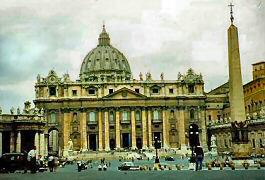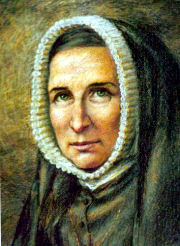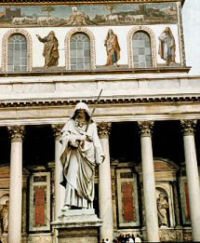Ordinary Time: November 18th
Wednesday of the Thirty-Third Week of Ordinary Time; Optional Memorials of the Dedication of the Churches of Peter and Paul, apostles; St. Rose Philippine Duchesne, virgin (USA)
» Enjoy our Liturgical Seasons series of e-books!
The whole Church celebrates today the dedication of the two great Roman basilicas of St. Peter at the Vatican and of St. Paul-outside-the-Walls. The basilica of St. Peter stands on the site of the tomb of the Prince of the Apostles, where stood Nero's circus. It was here that St. Peter was executed. Recent excavations have shown that the present basilica which, in the seventeenth century replaced the ancient Constantinian basilica, was built over the tomb of St. Peter, just as the previous basilica. It was consecrated by Urban VIII on November 18, 1626. St. Paul-outside-the-Walls, situated at the other end of the city on the Ostian Way, is built near the place St. Paul was martyred. It was almost completely destroyed by fire in 1823 and was rebuilt in sumptuous fashion by Gregory XVI and Pius IX and consecrated by the latter on December 10, 1854. The celebration of the anniversary of these two dedications has been kept, nevertheless, on November 18.
St. Rose was born in Grenoble, France in 1769, and became a Visitation nun during the French Revolution. After her convent was closed during the reign of terror, she joined the Society of the Sacred Heart. She was sent to the Louisiana territory as a missionary and founded a boarding school for daughters of pioneers near St. Louis and opened the first free school west of Missouri. She also began a school for Indians. She died in 1882 in St. Charles, Missouri, and was canonized in 1988.
Dedication of the Churches of Peter and Paul
 Today's feast is a spiritual journey to two holy tombs, that of St. Peter and that of St. Paul in Rome. These two basilicas, marking the place of each apostle's martyrdom, are the common heritage and glory of Christendom; it is, therefore, easily seen why we observe their dedication.
Today's feast is a spiritual journey to two holy tombs, that of St. Peter and that of St. Paul in Rome. These two basilicas, marking the place of each apostle's martyrdom, are the common heritage and glory of Christendom; it is, therefore, easily seen why we observe their dedication.
Abbot Herwegen makes the following observations on St. Peter's in Rome. The Eternal City has two principal churches, St. John Lateran and St. Peter's. Since ancient times the Lateran basilica, the mother of all churches on earth, has been the church proper to the bishop of Rome in his position as head of the local community. Here the Lenten season was opened and the Easter liturgy solemnized. The basilica of St. Peter, on the other hand, was the church of non-Romans, of pilgrims who journeyed to the city where the two great apostles were martyred. Here those celebrations were held which expressed the universal character of the Roman Church, e.g., Epiphany and the noon Mass on Christmas. The Introits, Lessons, and chants of both these feasts are best explained as proclaiming Christ's universal dominion and His royal majesty.
The third lesson gives the history regarding the construction of the two basilicas. Among the holy places which the first Christians held in honor, those sites were especially dear where the bodies of holy martyrs lay. Great veneration was accorded that area of the Vatican Hill where the grave of St. Peter was located. From all lands Christians made pilgrimages to it as to the rock of faith and the foundation of the Church. In due time the legend arose that Emperor Constantine the Great, eight days after his baptism, took off his diadem, threw himself humbly upon the earth, and shed many tears. Then with pick and shovel he started digging and, in memory of the twelve apostles, carried away twelve baskets of ground; thereby he set the boundaries of the basilica to be built in honor of St. Peter. When finished, the edifice was solemnly consecrated by Pope Sylvester I.
Pope Sylvester had ordered the altar to be of stone; he anointed it with chrism and decreed that in the future only stone altars were to be used. A new church, the present St. Peter's, was consecrated by Pope Urban VIII on November 18, 1626. The ancient basilica of St. Paul was destroyed by fire in 1823; a new structure was consecrated by Pius IX on December 10, 1854, the occasion of the proclamation of the dogma of the Immaculate Conception.
In the perspective of the liturgy, the two churches honored today are prime examples connoting the heavenly Jerusalem. The liturgy excels in the pedagogy of passing from the material to the supernatural — the precedent for which on the point in question was already set by the author of the Apocalypse.
Highlights and Things to Do: St. Rose Philippine Duchesne
In 1804 she joined the Religious of the Sacred Heart, founded by St. Madeline Sophie Barat. When Bishop Dubourg of New Orleans asked for nuns for his young American diocese, Philippine begged for permission to go with him. She was forty-nine years old when she arrived at St. Louis, Missouri, with four companions, and established the first convent of the Society at St. Charles.
Cold, hunger, illness, poverty, and opposition were the lot of the young community, but the indomitable courage of the holy foundress overcame all obstacles. She opened a school for Indians and whites at Florissant, the first free school west of the Mississippi. She established houses at various places which were the beginnings of noted schools and colleges conducted today by the Society. Her one ambition, however, was to work among the Indians. She was seventy-one years old when she obtained the coveted permission from Mother Barat, who wrote: "Don't try to stop her; it was for the Indians that she went to America."
With three companions she traveled by boat and oxcart to Sugar Creek, Kansas, to labor there among the Potawatomi's. Their convent was a wigwam, they slept on the bare ground, and the food was coarse. They opened a school for Indian girls and taught them sewing, weaving, and other household arts. Philippine thought herself a failure because she could not master English, much less the Indian language, but her holiness made a deep impression on the Indians who called her "the woman who always prays," because she spent so much time in the chapel. A priest said of her: "The Indians used her kindness as one uses water — without thinking of it, for they were sure of finding it always fresh and pure."
The severe winters and the lack of proper food sapped her health and she was sent back to St. Charles. Here she spent the last decade of her life, praying "for her Indians" and for the Society which she had established and which was growing rapidly. She died at St. Charles, thinking herself a failure, yet she was the first missionary nun among the Indians, blazing the trail for a host of valiant women who were to follow her.
Patronage: Opposition of Church authorities; diocese of Springfield-Cape Girardeau, Missouri.
Highlights and Things to Do:  Philippine was the daughter of a prominent French lawyer and was educated by the Visitation nuns, whom she later joined. During the French Revolution the Order was dispersed and for some years she served the sick and the poor as well as fugitive priests.
Philippine was the daughter of a prominent French lawyer and was educated by the Visitation nuns, whom she later joined. During the French Revolution the Order was dispersed and for some years she served the sick and the poor as well as fugitive priests.
—Excerpted from A Saint A Day, Berchmans Bittle, O.F.M.Cap








